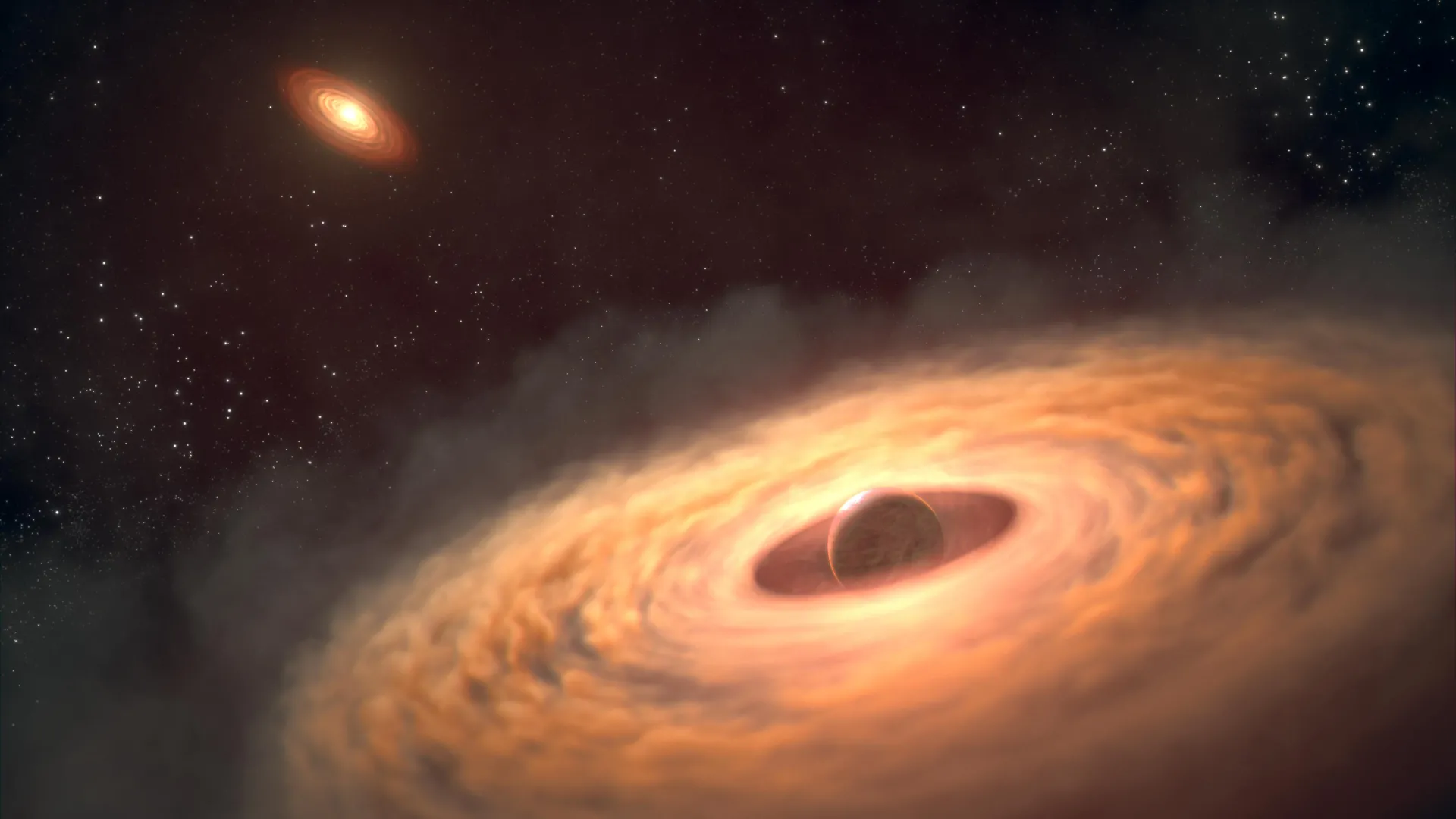James Webb spots a cosmic moon factory 625 light-years away
- Date:
- October 29, 2025
- Source:
- NASA Webb Mission Team
- Summary:
- NASA’s James Webb Space Telescope has captured the first detailed look at a carbon-rich disk surrounding the exoplanet CT Cha b, located about 625 light-years from Earth. The observations reveal a possible “moon factory,” where dust and gas could be coalescing into new moons. The planet orbits a young star only 2 million years old, and the disk’s composition offers rare insight into how moons and planets form in the early stages of a solar system’s life.
- Share:

NASA's James Webb Space Telescope has made the first direct measurements of both the chemical composition and physical conditions of a possible moon-forming disk surrounding a massive exoplanet. The carbon-rich disk encircles the planet known as CT Cha b, located about 625 light-years from Earth. While no moons were detected in the Webb data, the environment could serve as a birthplace for future moons, providing valuable insight into how such natural satellites come to exist.
The study describing these results appears in The Astrophysical Journal Letters.
A Young Star System in Its Earliest Stages
The star that CT Cha b orbits is only 2 million years old and is still gathering material from its surroundings. However, Webb's observations show that the smaller disk around the planet is separate from the larger one feeding the star. The planet and its star are an enormous 46 billion miles apart, revealing that they are distinct systems of activity.
Understanding how planets and moons form is essential to explaining how planetary systems evolve across the galaxy. Moons likely outnumber planets, and some may even support conditions suitable for life. Thanks to Webb's capabilities, astronomers are now beginning to directly observe these early moments of planetary and lunar development.
Tracing the Origins of Planetary Systems
Researchers say this finding is a breakthrough in understanding how planets and moons form and grow. Webb's detailed observations allow scientists to compare this young system with the early history of our own solar system, which took shape more than 4 billion years ago.
"We can see evidence of the disk around the companion, and we can study the chemistry for the first time. We're not just witnessing moon formation -- we're also witnessing this planet's formation," said co-lead author Sierra Grant of the Carnegie Institution for Science in Washington.
"We are seeing what material is accreting to build the planet and moons," added main lead author Gabriele Cugno of the University of Zürich and member of the National Center of Competence in Research PlanetS.
Unraveling the Light of a Distant Planet
To study CT Cha b, Webb used its MIRI (Mid-Infrared Instrument) and a medium resolution spectrograph. Early analyses of archived Webb data showed hints of molecules within the circumplanetary disk, prompting a more detailed investigation. Because the planet's faint glow is easily lost in the brightness of its host star, researchers applied high-contrast imaging techniques to separate the light of the planet from that of the star.
"We saw molecules at the location of the planet, and so we knew that there was stuff in there worth digging for and spending a year trying to tease out of the data. It really took a lot of perseverance," said Grant.
The team ultimately identified seven carbon-bearing molecules in the disk, including acetylene (C2H2) and benzene (C6H6). This strong carbon signature stands in sharp contrast to the chemistry of the star's own disk, where water is present but carbon is absent. The chemical differences between the two disks reveal how quickly these environments can evolve -- on the order of only 2 million years.
A Glimpse Into Moon Formation
Scientists have long theorized that Jupiter's four large moons -- Io, Europa, Ganymede, and Callisto -- originated from a similar disk surrounding the young planet billions of years ago. The alignment of their orbits supports this idea. The two outermost moons, Ganymede and Callisto, are composed of about 50% water ice but likely contain rocky cores rich in elements such as carbon or silicon.
"We want to learn more about how our solar system formed moons. This means that we need to look at other systems that are still under construction. We're trying to understand how it all works," said Cugno. "How do these moons come to be? What are their ingredients? What physical processes are at play, and over what timescales? Webb allows us to witness the drama of moon formation and investigate these questions observationally for the first time."
Over the next year, the research team plans to use Webb to study additional young planetary systems, aiming to compare the physical and chemical diversity among disks that may one day give rise to moons.
The James Webb Space Telescope is the world's leading space observatory, designed to explore the universe with unmatched precision. It is helping scientists unlock mysteries of our solar system, study distant planets orbiting other stars, and peer back to the earliest galaxies that shaped the cosmos. Webb is an international partnership between NASA, the European Space Agency (ESA), and the Canadian Space Agency (CSA), combining advanced technology and global collaboration to expand our understanding of the universe and our place within it.
Story Source:
Materials provided by NASA Webb Mission Team. Note: Content may be edited for style and length.
Journal Reference:
- Gabriele Cugno, Sierra L. Grant. A Carbon-rich Disk Surrounding a Planetary-mass Companion. The Astrophysical Journal Letters, 2025; 991 (2): L46 DOI: 10.3847/2041-8213/ae0290
Cite This Page: